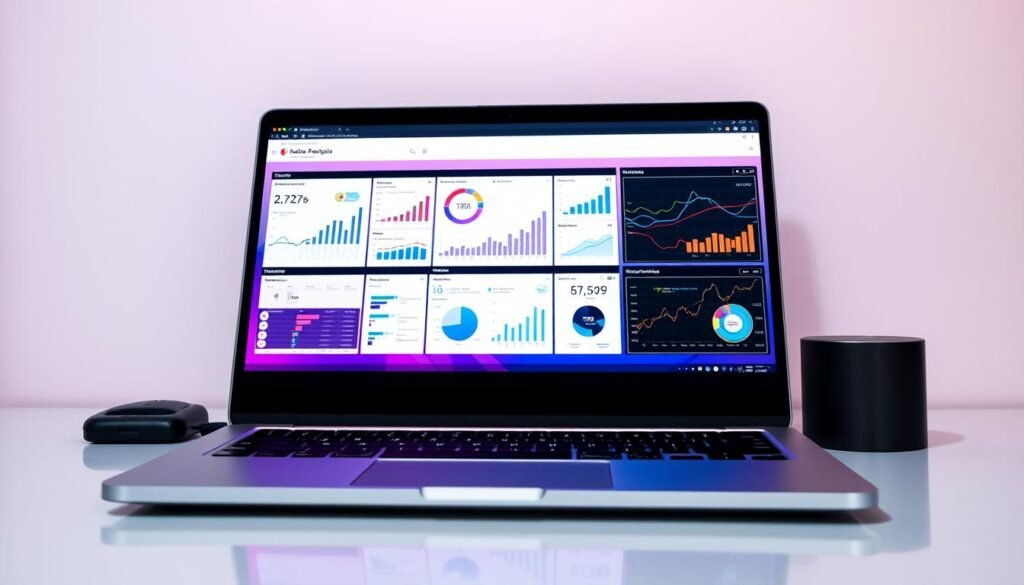What if mastering data could unlock doors you never imagined? As someone who transformed raw numbers into impactful insights for Fortune 500 companies, I’ve seen firsthand how this skill reshapes careers. Let me simplify your path to joining this dynamic field.
The demand for professionals who interpret trends and drive decisions has exploded. The U.S. Bureau of Labor Statistics predicts 25% growth for related roles through 2032, far outpacing average job markets. When I started, I leveraged certifications in SQL and Python alongside my economics degree, but structured learning accelerated my progress.
This guide shares the exact roadmap I wish I’d had. You’ll discover why focusing on critical thinking matters more than memorizing tools, how to choose between bootcamps vs traditional degrees, and strategies to showcase your abilities to employers. Let’s turn your curiosity into expertise.
Table of Contents
Key Takeaways
- Data-driven roles are growing 25% faster than average occupations
- Technical skills like SQL and Python form the foundation of analysis work
- Certifications often provide faster entry points than four-year degrees
- Real-world projects demonstrate competence better than theoretical knowledge
- Business acumen separates adequate analysts from indispensable ones
Understanding the Data Analyst Landscape
Modern organizations thrive on insights hidden within raw numbers. During my early consulting years, I witnessed companies pivot entire strategies based on patterns uncovered through analytics. This field bridges technical expertise and business outcomes, a dynamic space where curiosity meets impact.
Also Read: Why Data Analytics Is Your Secret Weapon for Success
Overview of the Data Analytics Field
Data analytics transforms information into actionable intelligence. Professionals in this domain identify trends, forecast outcomes, and communicate findings through tools like Python or Tableau. Entry-level roles often focus on data cleaning and reporting, while senior positions influence executive decisions.
Industries from healthcare to finance now rely on these skills. For example, retail companies use purchase histories to optimize inventory, while hospitals analyze patient data to improve care. Below is a breakdown of sectors actively hiring:
| Industry | Common Roles | Key Tools |
|---|---|---|
| Technology | Business Intelligence Analyst | SQL, Power BI |
| Healthcare | Clinical Data Specialist | Excel, SAS |
| Finance | Risk Analyst | R, Tableau |
Industry Trends in the United States
The U.S. job market reflects surging demand. According to Forbes, 72% of executives prioritize hiring analytical talent. States like Texas and California lead in openings, particularly for roles requiring Python or machine learning basics.
Consider these regional growth patterns:
| State | Projected Growth (2023-2028) | Top Employers |
|---|---|---|
| California | 31% | Tech startups, healthcare systems |
| New York | 28% | Banks, marketing agencies |
| Texas | 27% | Energy companies, logistics firms |
I’ve mentored professionals who transitioned into entry-level data analyst positions within six months by mastering Excel and SQL. As one client shared, “Learning to visualize data changed how I contribute to team meetings.” This career path rewards both technical skill and strategic thinking.
Setting a Solid Foundation in Data Analytics
Building expertise starts with selecting learning tools that match your strengths. When I mentored career changers, those who aligned their education with personal goals progressed fastest. Let’s explore pathways that turn curiosity into capability.
Also Read: Benefits of Data Analytics
Educational Paths and Certifications
Formal degrees offer structured learning but require significant time. Accelerated options like IBM’s Professional Certificate teach Python and SQL through real-world projects. One student shared, “The certificate’s retail sales case study helped me land my first role.”
| Option | Duration | Cost Range | Focus Areas |
|---|---|---|---|
| Bachelor’s Degree | 4 years | $30k-$100k | Statistics, databases |
| Coding Bootcamp | 3-6 months | $5k-$20k | SQL, visualization |
| Professional Certificates | 2-6 months | $300-$2k | Industry-specific tools |
Core Competencies for Beginners
Math fundamentals matter, especially statistics and algebra. Pair these with spreadsheet mastery before tackling complex tools. I prioritize three skills in early training:
- Problem decomposition: Breaking questions into solvable parts
- Data hygiene: Cleaning datasets efficiently
- Tool flexibility: Switching between Excel and Python
Continuous learning separates thriving professionals from those who plateau. A marketing specialist I coached doubled her salary by adding Tableau to her Excel skills. Start small, iterate often, and let each success fuel your next step.
Essential Technical Skills for Data Analysis
Technical mastery transforms raw numbers into business gold. When I first analyzed customer churn patterns for a telecom client, Python and Tableau became my most trusted allies. Tools matter, but their strategic application separates competent professionals from industry leaders.

Programming Languages and Statistical Tools
Python and R form the backbone of modern analytics. My early career breakthrough came through automating reports with Pandas, a skill that tripled my productivity. Consider these core languages:
| Tool | Strengths | Common Uses |
|---|---|---|
| Python | Versatile libraries | Machine learning pipelines |
| R | Statistical modeling | Academic research |
| SQL | Database queries | Transactional analysis |
Jupyter Notebook remains my go-to for exploratory analysis. One marketing dashboard I built using these tools revealed $2M in untapped revenue, proof that technical skills directly impact outcomes.
Data Visualization and Reporting Techniques
Clear visuals make insights stick. During a healthcare project, interactive Tableau dashboards helped doctors identify treatment gaps faster. Key principles I follow:
- Prioritize clarity over decorative elements
- Use color intentionally to highlight trends
- Match chart types to data relationships
Excel still dominates boardroom discussions despite newer tools. A recent survey shows 68% of executives prefer spreadsheet-based reports for quick decisions. Balance innovation with practicality when choosing visualization methods.
Mastering Data Cleaning and Preparation
Dirty data costs businesses millions annually, yet remains the most overlooked step in analysis. Early in my career, I spent three weeks fixing a retail client’s sales dataset before meaningful insights emerged. This process isn’t glamorous, but it’s where 80% of analytical work happens behind the scenes.
Methods for Cleaning and Normalizing Data
Effective cleaning starts with identifying inconsistencies. I prioritize removing duplicates using Python’s Pandas library or Excel’s conditional formatting. Missing values require strategy: delete incomplete records, use averages, or apply predictive modeling. One healthcare project taught me to always validate against source systems after normalization.
| Technique | Tool | Use Case |
|---|---|---|
| Deduplication | OpenRefine | Customer databases |
| Outlier detection | Python (Seaborn) | Financial transactions |
| Standardization | SQL REGEX | Address formatting |
Best Practices in Data Preparation
Document every transformation, you’ll thank yourself during peer reviews. For entry-level data roles, I recommend starting with small datasets before tackling enterprise-level information. Common pitfalls include:
- Overlooking timestamp formatting differences
- Failing to back up original files
- Ignoring business context during normalization
Data science teams at top firms spend 45% less time reworking analyses when they implement version control early. My personal rule? Clean iteratively, address obvious issues first, then refine through multiple passes.
How to be a data analyst: Roadmap and Strategies
Structured skill development separates aspiring professionals from job-ready candidates. Early in my career, a mentor shared a truth: “Tools evolve, but systematic learning creates lasting value.” This philosophy shaped my approach to mastering analytical competencies.
Step-by-Step Approach to Skill Acquisition
Begin with spreadsheet fundamentals before tackling complex programming languages. I prioritized Excel for basic calculations and pivot tables, then progressed to Python for automation. IBM’s certification program helped me bridge these skills through retail inventory case studies.
Strategic milestones accelerate growth. Consider this progression:
- Month 1-2: Master data cleaning with Excel/Google Sheets
- Month 3-4: Build SQL queries for database extraction
- Month 5-6: Apply statistical analysis using Python libraries
Project-based courses from Google and Coursera provide realistic scenarios. One healthcare analysis module taught me to visualize data trends affecting patient wait times, skills directly applicable to my first consulting role.
Weekly practice challenges maintain momentum. I still recreate real-world scenarios using public datasets from Kaggle. This habit sharpens technical abilities while building portfolio-ready work. As tools advance, foundational methods remain critical for interpreting information accurately.
Gaining Real-World Experience Through Projects
Portfolios speak louder than résumés in this field. When a logistics company hired me based on my GitHub repository, I realized tangible proof of competence outweighs generic credentials. Practical projects bridge classroom concepts and workplace demands.

Building and Showcasing a Portfolio
Curate 3-5 projects demonstrating diverse capabilities. My first portfolio included a sales trend dashboard and a Python script automating report generation. Platforms like Tableau Public and GitHub let employers interact with your work directly. One mentee secured interviews by highlighting a COVID-19 vaccination analysis that identified distribution bottlenecks.
Effective portfolios balance complexity with clarity. Focus on:
- Relevance: Align projects with target industries
- Documentation: Explain methodologies in README files
- Visual appeal: Use screenshots and live links
Engaging with Real-World Data Sets
Public repositories offer goldmines for practice. I often use U.S. Census data for demographic studies and NYC OpenData for transportation patterns. These resources expose you to messy, imperfect information, mirroring workplace challenges.
A financial services intern shared: “Analyzing Federal Reserve economic indicators taught me more about data hygiene than any textbook.” Platforms like Kaggle and Google Dataset Search provide structured scenarios to test your analytical muscles.
| Platform | Dataset Type | Skill Focus |
|---|---|---|
| Kaggle | Competition-ready | Predictive modeling |
| Data.gov | Government records | Trend identification |
| GitHub | User-generated | Collaboration workflows |
Treat every project as a potential portfolio piece. The process of scraping, cleaning, and visualizing data builds muscle memory for critical tasks. These hands-on experiences transform theoretical knowledge into market-ready expertise.
Developing Professional Communication and Presentation Skills
Numbers alone rarely convince stakeholders, stories do. Early in my career, I watched a sales forecast presentation fall flat until we reframed the data as a narrative about customer retention. This shift transformed confused glances into actionable decisions.
Translating Data Insights into Stories
Analytical findings gain power when wrapped in relatable contexts. For a healthcare client, comparing patient wait times to airport security lines made complex metrics tangible. Key strategies include:
- Identifying the audience’s priorities before structuring the message
- Using analogies to simplify technical concepts
- Highlighting one core insight per visualization
A project manager once told me, “Your dashboard didn’t just show numbers, it showed our team’s path forward.” That’s the impact of strategic storytelling.
Effective Presentation Techniques
Clarity trumps complexity in business settings. I design slides with three-second readability: any chart should make sense at a glance. Tools like Canva or PowerPoint’s Designer feature help create polished visuals without graphic design expertise.
Practice transforms nervous energy into confidence. Record yourself explaining a recent project’s results, then review for:
- Jargon-free language
- Consistent pacing
- Natural gestures
Career growth in analytical roles often hinges on bridging the gap between spreadsheets and boardrooms. One mentee doubled interview callbacks by adding storytelling examples to her portfolio, proof that communication skills amplify technical prowess.
Utilizing Certifications and Continued Learning
Credentials unlock doors faster than raw talent alone. Early in my career, completing the Google Data Analytics Certificate transformed how employers perceived my capabilities, even with limited work experience. Structured programs validate skills through industry-recognized benchmarks, creating tangible proof of competence.
Strategic Credential Selection
Top certifications blend practical skills with business relevance. The IBM Data Analyst Professional Certificate stands out for its focus on real-world scenarios like sales forecasting. Microsoft’s Power BI certification similarly bridges technical prowess with executive reporting needs. Consider these options:
| Program | Duration | Key Skills |
|---|---|---|
| Google Certificate | 6 months | Spreadsheets, SQL |
| IBM Certificate | 3 months | Python, data visualization |
| Tableau Desktop Specialist | 1 month | Dashboard creation |
Industry surveys show 83% of hiring managers prioritize candidates with relevant certifications. One mentee landed a healthcare analytics role after completing a HIPAA-focused course, proof that specialized credentials create differentiation.
Continuous learning maintains career momentum. I dedicate two hours weekly to exploring new tools like KNIME or advanced Excel functions. This habit helped me transition from basic reporting to predictive modeling within eighteen months. As technologies evolve, staying current becomes non-negotiable.
Time management proves critical. Block calendar slots for skill development just like client meetings. A financial analyst I coached increased her promotion chances by completing certifications during slow business quarters. Treat learning as a professional investment, not an optional hobby.
Leveraging Industry Insights and Market Trends
The analytics landscape shifts faster than most professionals anticipate. Recent reports show 82% of organizations now use advanced tools beyond spreadsheets, creating new opportunities for those who track emerging patterns. Staying ahead requires equal parts technical skill and market awareness.
Analyzing Current Job Market Data
Healthcare and renewable energy sectors lead demand growth, with job postings increasing 34% year-over-year. LinkedIn’s 2024 Workforce Report highlights Python and Power BI as top tools across these fields. Key patterns emerge:
| Industry | Growth Rate | In-Demand Tools |
|---|---|---|
| Healthcare Tech | 39% | Tableau, Epic Systems |
| Clean Energy | 41% | Python, GIS Mapping |
| E-commerce | 28% | SQL, Google Analytics |
I shifted my learning focus to spatial analysis tools after noticing energy companies’ hiring surges, a decision that led to three consulting offers within months.
Growth Opportunities in Data Analytics
Real-time analytics and AI integration dominate innovation. Platforms like Coursera report 57% enrollment spikes in courses covering these areas. Professionals who master tools like Databricks or Snowflake position themselves for roles shaping business strategies rather than just supporting them.
One insight changed my career trajectory: “Tools evolve, but problem-solving frameworks endure.” Balancing technical upskilling with strategic thinking creates lasting relevance in this dynamic field.
Exploring Career Opportunities and Entry-Level Roles
Breaking into analytical roles requires more than technical prowess, it demands strategic navigation of today’s competitive job market. When I helped a recent graduate land three interviews within weeks, their secret weapon wasn’t flawless code but a targeted approach to showcasing value.
Job Search Strategies That Deliver Results
Tailor every application like a precision tool. Highlight projects demonstrating programming skills in Python or SQL, not just coursework. One mentee secured a healthcare analytics role by emphasizing her Medicare claims analysis, a direct match for the employer’s needs.
Platforms like LinkedIn and GitHub serve dual purposes:
- Showcase interactive dashboards and clean code repositories
- Follow companies hiring for roles requiring your skillset
- Engage with industry-specific content to demonstrate passion
| Platform | Best Use | Success Metric |
|---|---|---|
| Networking | 5+ meaningful connections weekly | |
| GitHub | Portfolio building | 3 starred repositories |
| Indeed | Job alerts | 10 relevant postings/month |
Cultivating Professional Relationships
Mentorship accelerates learning curves exponentially. My first industry contact came from commenting on a data visualization blog post, a conversation that evolved into monthly coffee chats. Effective outreach strategies include:
- Personalizing connection requests with specific praise for work
- Joining local meetups focused on statistical programming
- Volunteering for non-profit data projects to gain references
“Asking thoughtful questions opened more doors than my GPA ever did,” shared a former intern now leading retail analytics at a Fortune 500 company. This field rewards those who pair technical skills with relationship-building savvy.
Preparing for Data Analyst Interviews
Interview rooms feel less intimidating when you’ve decoded their hidden patterns. My first technical screening involved explaining a Python script while whiteboarding, a moment where preparation met opportunity. Success hinges on blending technical prowess with human connection.
Common Interview Questions
Expect three question types: technical, behavioral, and case studies. For SQL challenges, I practice on platforms like LeetCode using real company databases. Behavioral queries often start with “Tell me about a time…”, structure responses using the STAR method (Situation, Task, Action, Result).
Top questions I’ve encountered:
- “Walk through your process for cleaning incomplete datasets”
- “How would you explain p-values to non-technical stakeholders?”
- “Describe a project where your analysis influenced decisions”
Tips for a Successful Interview
Research the company’s data stack and industry challenges beforehand. During a fintech interview, referencing their fraud detection metrics demonstrated genuine interest. Simplify technical language without diluting accuracy, think “customer patterns” instead of “clustering algorithms.”
Mock interviews build muscle memory. I record myself answering timed questions, focusing on pacing and clarity. One strategy that worked: structuring technical explanations as stories. A hiring manager once noted, “You made SQL joins sound like solving a mystery, that’s rare.”
Conclusion
Every dataset tells a story, your ability to interpret it writes your career narrative. My journey from spreadsheet novice to strategic advisor taught me this truth: lasting success blends technical skill with relentless curiosity.
Build your foundation through certifications and hands-on projects. Strengthen it by translating numbers into actionable insights. The knowledge you gain today becomes tomorrow’s competitive edge.
This field evolves rapidly. What worked last year might fade next quarter. Stay hungry, master new tools while deepening your understanding of data science principles. One client engagement taught me more about predictive modeling than any textbook.
Your path won’t mirror mine exactly. Find your way by embracing challenges as learning accelerators. A retail inventory analysis I completed five years ago still informs my approach to complex problems.
Start small. Iterate often. Let each project sharpen your knowledge and confidence. The science of data rewards those who persist, your breakthrough awaits.
FAQ
What technical skills are critical for entry-level data analyst roles?
I prioritize proficiency in programming languages like Python or R, SQL for database queries, and tools like Excel. Familiarity with statistical analysis and visualization platforms such as Tableau or Power BI also strengthens candidacy for analytics jobs.
How do I build a competitive portfolio without prior experience?
I start by working on personal projects using public datasets from Kaggle or government sources. Showcasing cleaned data, visualizations, and actionable insights demonstrates practical abilities. Platforms like GitHub or LinkedIn help highlight these career-ready examples.
Which certifications add value to a data analyst resume?
I recommend Google’s Data Analytics Certificate, Microsoft’s Power BI certification, or IBM’s Data Science Professional Certificate. Coursera and edX also offer industry-recognized programs that validate analytical and technical competencies.
What industries in the U.S. have high demand for data analysts?
I observe strong growth in healthcare, finance, e-commerce, and tech sectors. Companies like Amazon, UnitedHealth Group, and JPMorgan Chase actively seek professionals who can translate complex data into strategic decisions.
How important are soft skills for succeeding in analytics roles?
I emphasize storytelling and communication, transforming raw numbers into narratives stakeholders understand. Collaboration, problem-solving, and attention to detail also differentiate top candidates in team-driven environments.
Can I transition into data analytics without a STEM degree?
Yes. I’ve seen professionals from marketing, economics, or social sciences succeed by mastering tools like SQL and Python. Bootcamps, online courses, and hands-on projects effectively bridge knowledge gaps for career changers.
What interview questions should I prepare for?
I practice explaining my project workflow, handling missing data scenarios, and solving SQL/Python challenges. Behavioral questions like “Describe a time you influenced a decision with data” test both technical and communication abilities.














